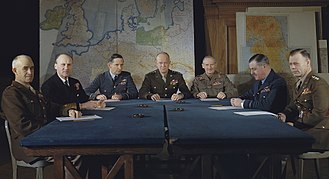
The broad front versus narrow front controversy in World War II arose after General Dwight D. Eisenhower, the Supreme Allied Commander, decided to advance into Germany on a broad front in 1944, against the suggestions of his principal subordinates, Lieutenant Generals Omar Bradley and George S. Patton and Field Marshal Sir Bernard Montgomery, who argued instead to stage competing advances on narrow fronts. The decision was controversial initially because the British government wanted to raise the profile of the minority British contingent in what was by then an overwhelmingly American army, and they perceived that a British-led thrust to Berlin would achieve this aim. Montgomery's strident advocacy raised political and nationalistic complications that strained the wartime alliance. During the subsequent Cold War, suggestions were made that the Soviet presence in Eastern Europe may have been reduced had Eisenhower sent a narrow-front thrust to race the USSR to Berlin in 1945.
Eisenhower's decision was based on both political and military factors. There were serious reservations in the autumn of 1944 about whether the Allied logistical system could support the narrow-front strategy, because at that time there were insufficient working ports to support large formations far from the coast, the road and rail transport network was already under severe strain, and there were concerns about being able to protect the narrow supply lines deep into enemy territory, through terrain that included crossing many rivers, in weather which hampered air support. In addition the Allied occupation zones in Germany had been agreed upon in February 1944, and a faster Allied advance in the autumn of 1944 would not have altered this. The Soviet Union would have also benefited from a rapid German collapse, and its participation in the war against Japan was greatly desired. The staff at Eisenhower's Supreme Headquarters Allied Expeditionary Force (SHAEF) considered Montgomery's proposed advance on the Ruhr and Berlin and Bradley's proposed advance on Metz and the Saar, and assessed both to be feasible, but only on the assumptions that the port of Antwerp was brought rapidly into service, that considerable additional air, rail and road transportation became available, and that the other Allied armies were already poised on the German border. These assumptions were not met until very late in the year, by which time circumstances had changed. The consequences if the narrow front advance had failed, would have been severe.
The British historian A. J. P. Taylor credited Chester Wilmot's The Struggle For Europe (1952) as the work that "launched the myths that Eisenhower prevented Montgomery from winning the war in 1944".[1] Few historians on either side of the Atlantic accept ending the war in 1944 was possible. "Wilmot's book", American historian Maurice Matloff wrote, "must be taken for what it represents—a suggestive, provocative work on the war written from a British point of view in a period of disenchantment."[2] Montgomery's Chief of Staff, Major-General Freddie de Guingand, stated in his post-war account that he had opposed Montgomery's narrow front strategy on political and administrative grounds, but Montgomery's wartime Chief Administrative Officer, Major-General Miles Graham defended his contention that the narrow front advance was logistically feasible.
- ^ Taylor 1965, p. 647.
- ^ Matloff 1971, p. 127.
